Menus
- Great
- For beginners and advanced, for young and old
- Almost 60 Nm already at 2000 rpm
- Twin turns furiously up to higher speeds if required
- Yamaha MT-07 provides good feedback
- List of minus points turns out to be small
- Good motorcycle for little money
- Yamaha’s nimble twin
- Technical specifications
- MOTORCYCLE measurements
- MOTORCYCLE scoring
- Conclusion
- Offers for the Yamaha MT-07
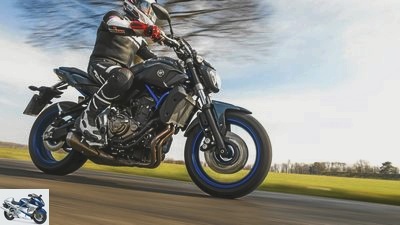
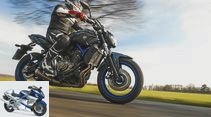
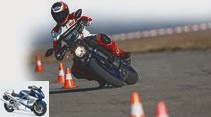
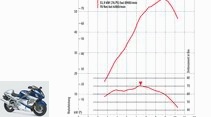
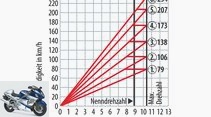
32 photos
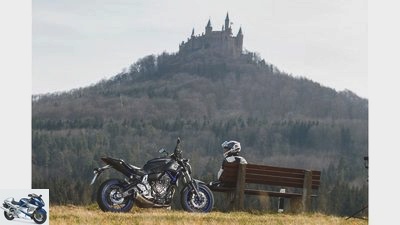
1/32
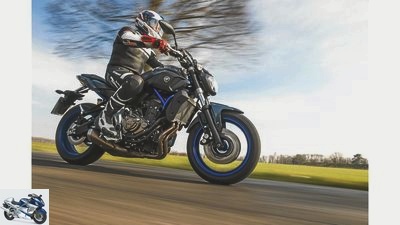
2/32
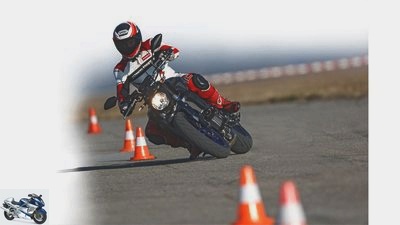
3/32
Only limit the incline buttons on the footrests – but they wear out over time anyway.
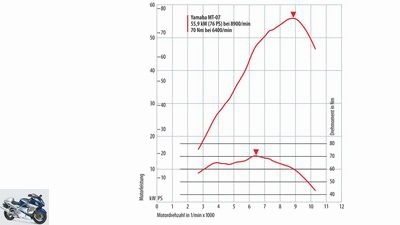
4/32
The torque back is impressive for a vehicle of this displacement category. Between 3000 and 9000 rpm, the twin never produces less than 60 Nm – that is extremely user and everyday-friendly.
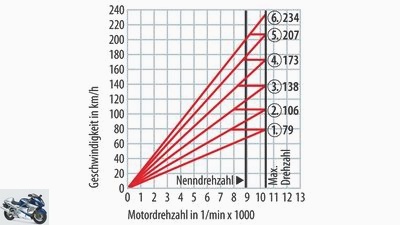
5/32
The gear ratio was successful, in the sixth the machine reaches its top speed with maximum performance.
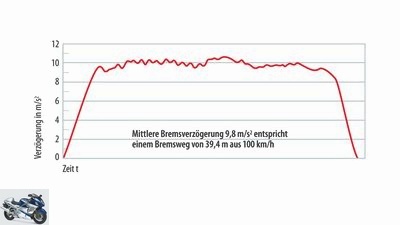
6/32
Also well coordinated: even with radical braking maneuvers several times in a row, the double disc remains free from fading.
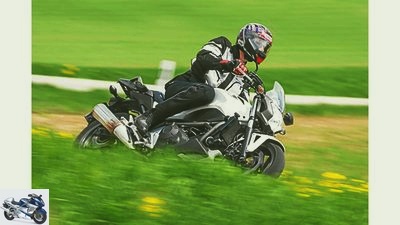
7/32
Competition: Honda NC 700 S..
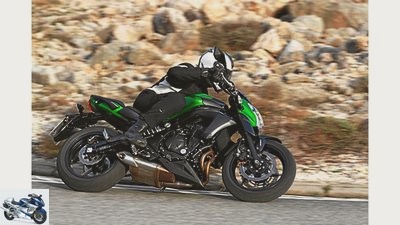
8/32
Competition: Kawasaki ER-6n.
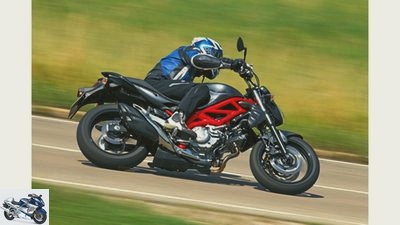
9/32
Competition: Suzuki Gladius.
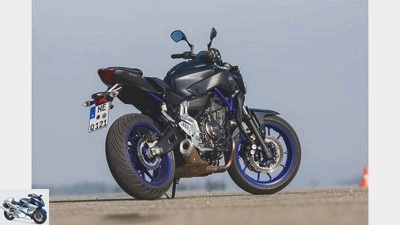
10/32
The Yamaha MT-07 offers a lot of motorcycles for comparatively little money.
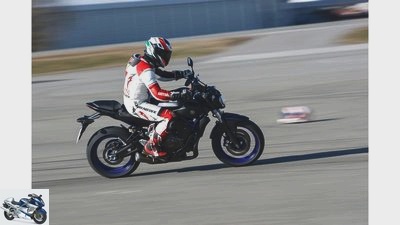
11/32
Freaks should treat the Yamaha MT-07 to a firmer shock absorber and stronger fork springs.
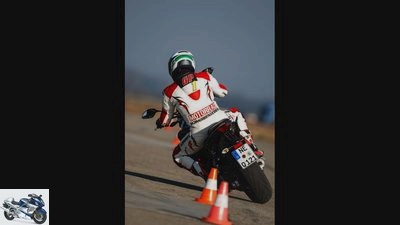
12/32
Yamaha names beginners and advanced drivers between the ages of 25 and 35 as the target group for the Yamaha MT-07.
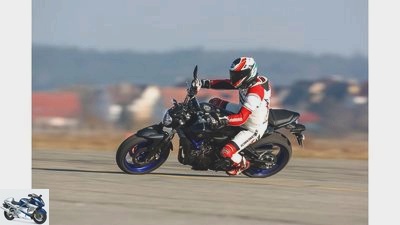
13/32
At constant speeds you can feel a somewhat stronger tingling sensation at speeds around 5500 rpm.
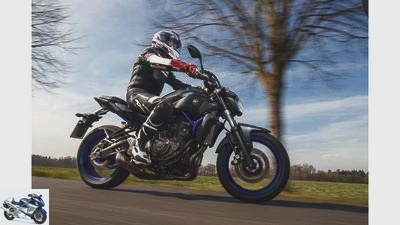
14/32
Power, handiness, features, design and an affordable price: the Yamaha MT-07.
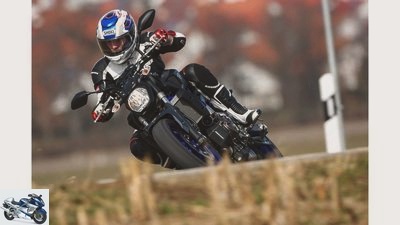
15/32
Buyers have to invest an additional 500 euros for a Yamaha MT-07 with ABS.
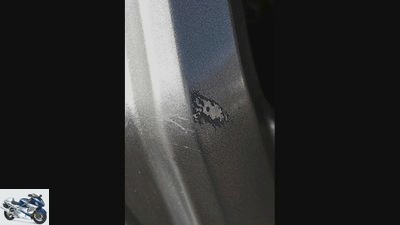
16/32
Quickly remove the paint: The side frame panels are made of aluminum, but the boots still rub off the paint easily.
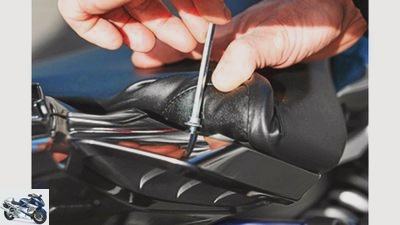
17/32
Not at the push of a button and not with a lock: the bench is fastened with two screws.
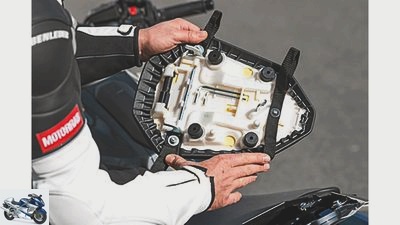
18/32
Also included: There are four loops under the pillion bench that can be folded out to better secure luggage.
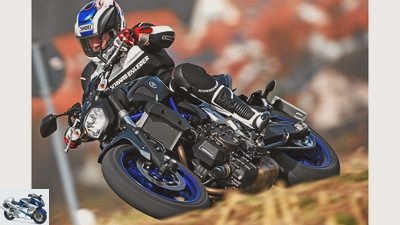
19/32
An incredibly beautiful lightness of being: The MT-07 can be handled playfully in any situation.
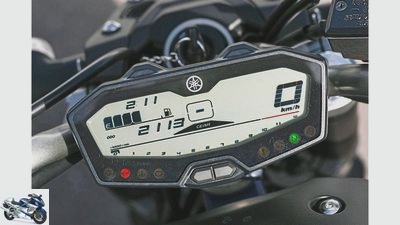
20/32
Easy to read and everything you need as a newcomer or old hand in it.
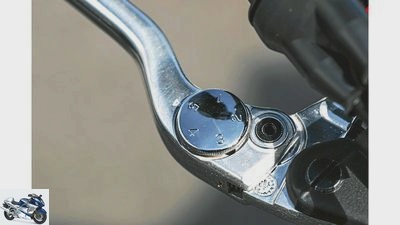
21/32
The hand lever for the front brake can be adjusted to various finger lengths.
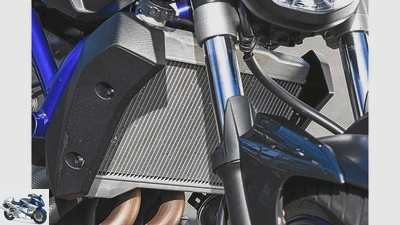
22/32
Design or austerity? The wide radiator is not painted.
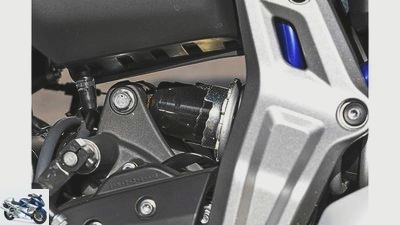
23/32
The suspension strut is progressively articulated via levers and is supported at the front of the engine.
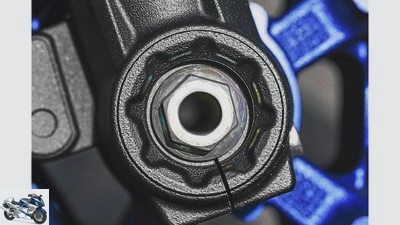
24/32
Design gimmick: the axle mounts are encircled in a star shape.
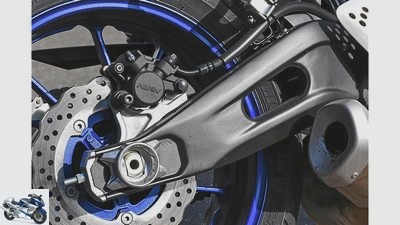
25/32
The swing arm, which is only 530 millimeters long, is formed from sheet steel, but looks very valuable.
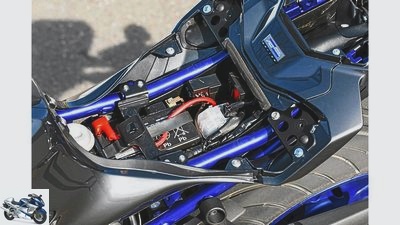
26/32
It is quite tight under the bench, there was no space for a storage compartment.
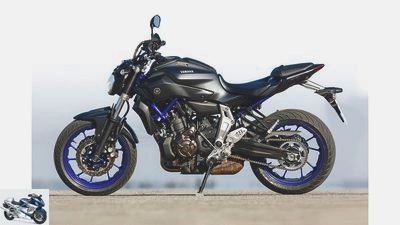
27/32
Easy to see: the masses are concentrated around the engine. Not visible: The splash guard on the rear fender is very poor.
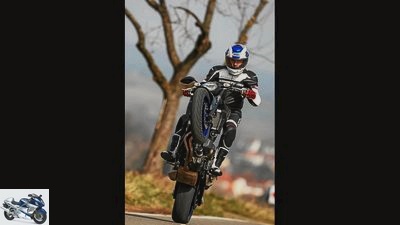
28/32
Good to see: the entire exhaust system is made of stainless steel, the manifolds are curved.
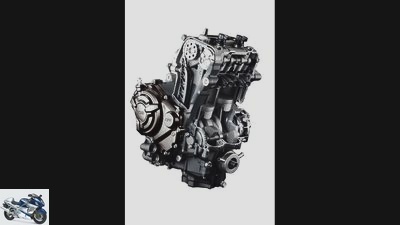
29/32
Extremely compact: In the MT-07-Twin, a crankshaft rotates with a 270 degree crank pin offset. The technicians positioned a balancer shaft directly in front of the crankshaft, …
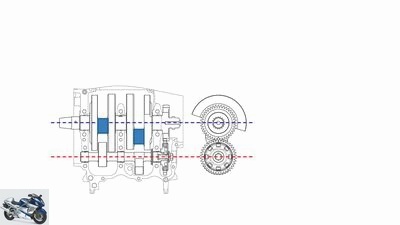
30/32
… to reduce the vibrations of the twin to a bearable level. The drive wheel for this purpose is pressed to the crankshaft.
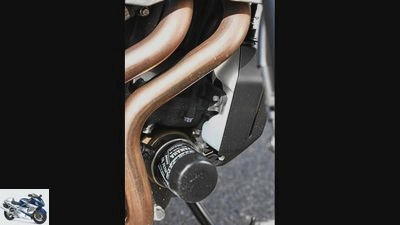
31/32
Noticed: The mechanic grins: The oil filter is freely accessible, which saves time for the customer and trouble in the workshop.
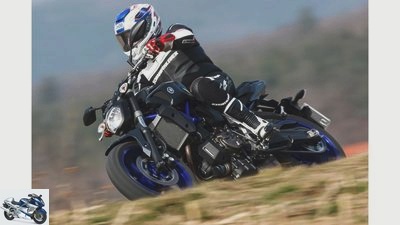
32/32
Yamaha MT-07 in the top test
Great
They gave it everything along the way: power, handiness, features, design. Not to forget the low price. Everything great. But how does the Yamaha MT-07 fare in everyday life and in the top test course?
Let’s just start this story in your garage. You went to the Yamaha dealer, flipped the comparatively cheap 5495 euros on the counter and took a brand new motorcycle home with you: the new Yamaha MT-07. But without ABS. With the anti-lock braking system it costs M.T-07 a whole 500 euros more. Now she stands there, surrounded by curious neighbors and friends who are actually unanimously enthusiastic about the look. No wonder. Because the MT-07 is cheap, but by no means looks cheap.
Buy complete article
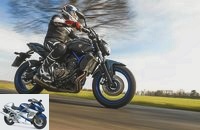
Yamaha MT-07 in the top test
Great
For example, the Yamaha MT-07 is made entirely of stainless steel. There is an LED rear light and a multi-reflector headlight. The front brake calipers have the look of the superbikes, the rims are identical to those of the slightly more expensive MT-09, and the paint also makes a valuable impression. You can find little design snacks at every corner. Such as, for example, wave design brake discs or decorated axle mounts. The rear end is short and stylish, as is the headlight, and the coating on the engine is nowhere near as if it was determined by the red pencil.
The strong, asymmetrically shaped swing arm looks really valuable, which in the end only consists of welded sheet steel parts, but looks great. The display of the cockpit shows everything that makes the slightly spoiled European happy: two day trips, total kilometers, gear, fuel level with remaining trip counter, engine speed, time, cooling water and outside temperature. They even thought of the mechanics and installed the oil filter in an easily accessible way. No, at first glance there is really nothing that can be criticized for the Yamaha MT-07.
For beginners and advanced, for young and old
And on the second? This requires an extensive test drive. Get in the saddle. The handlebars sit comfortably in the hand, the seat is not particularly high at 810 millimeters, and in conjunction with the narrow waist, even those with short legs can safely reach the floor. You sit comfortably on the new Yamaha. A 1.60 meter tall driver will be just as satisfied as the 1.95 meter tall driver. And here you can already see the design of the Yamaha MT-07: extremes are not in demand. The machine wants to make as large an intersection as possible happy. Yamaha names beginners and advanced drivers between the ages of 25 and 35 as the target group. If you want to enjoy the tank volume of 14 liters, patience is required. It sometimes takes two or three minutes longer to fill the petrol barrel to the brim because the last liter takes its time.
Allowing time is a good keyword anyway. There are engines that don’t give you time. Always want to be turned, cling roughly to the gas, annoy with vibrations and demand your full attention. The drive of the Yamaha MT-07 is exactly the opposite. And that makes him extremely personable in every way. Let’s start with its basic concept: a twin with a 270 degree crank pin offset. Here both pistons do not whiz up and down in parallel, but slightly offset. The resulting vibrations can be reduced with the help of a balancer shaft, but in terms of maximum performance, this construction with its irregular ignition offset does not provide any particular advantages. But it determines the character of the engine. The twin sounds like a 90 degree V2. And it also feels different to a co-runner or a counter-runner. More robust, freer, more agile. So much for theory.
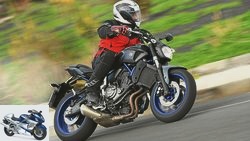
Naked bike
Yamaha MT-07 in the driving report
So easy. So controllable.
read more

Naked bike
Yamaha MT-07 and Kawasaki ER-6n in comparison test
Star ensemble of the middle class
read more
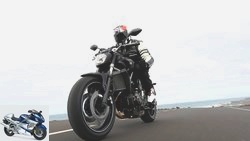
Naked bike
Yamaha MT-07 in the HP driving report
That knocks the PS tester off his stool
read more
Almost 60 Nm already at 2000 rpm
In practice, this small 689 cubic drive is a constant source of joy. First of all, it makes the MOTORRAD technicians happy: The test bench attests to it 76 hp at 8900 rpm and a maximum torque of 70 Nm at 6400 rpm. These highs alone do not mean anything. But in direct comparison with the performance outputs of the current competition, bikes like the Kawasaki ER-6n or the Suzuki Gladius look old in every respect: the drive of the Yamaha MT-07 already produces almost 60 Nm and thus ten Nm more than at 2000 rpm the competitors. He maintains this lead up to 6000 tours.
In terms of performance, the situation is similar: between 2000 and 7000 rpm, the MT drive always pumps between three and six more horsepower to the rear wheel, while the three drives give themselves almost nothing in the last third of the speed. This is of course also noticeable in the performance: In all areas, acceleration and pulling power, the Yamaha engine is ahead. To give you numbers: For example, the Yamaha MT-07 only needs 3.8 seconds from 0 to 100 km / h, from 0 to 150 km / h just 7.9 seconds, taking a few tenths off the competition. The same applies to the draft.
Twin turns furiously up to higher speeds if required
More important than all these number games, however, is the drive’s suitability for everyday use. Here, too, he makes the drivers grin. All of them. Regardless of whether you are a novice driver or an experienced rabbit. The twin already feels powerful at 2000 rpm, and the driver can shift into the next higher gear at 4000 rpm at the latest. The engine of the Yamaha MT-07 is so powerful that you spend 90 percent of the time with it between 3000 and 6000 rpm, although it could turn up to almost 10 500 rpm. It can be driven lazily, hangs wonderfully gently on the gas, reacts perfectly to gas commands and, if necessary, turns furiously up to higher speeds. If this twin were human, one would say: He is always relaxed, never appears stressed and is extremely resilient and powerful. So the ideal partner?
Good to see: the entire exhaust system is made of stainless steel, the manifolds are curved.
Well, there are a few rough edges. At constant speeds, for example on stretches of the motorway, you can feel a somewhat stronger tingling sensation at speeds around 5500 rpm. That corresponds to 120 km / h in sixth gear. What helps? Drive faster or downshift, of course. And there we come to the second minus point, because you can’t sing praises of the transmission of the Yamaha MT-07. On the test machine, the gears shifted cleanly, but a little bit hooked. But maybe this effect is there with increasing kilometers. The load change responses could also be somewhat lower.
But that’s complaining at a high level. The particularly good news: The fun doesn’t even cost much. Anyone who casually cruises through the area with the MT consumes only 3.5 liters per 100 km. So if you take it easy, the Yamaha MT-07 will carry you 400 kilometers on one tank of fuel. On the highway stretches with an average of 130 km / h, the engine treats itself to 4.7 liters per 100 km. Only real full-throttle junkies, who constantly chase the MT-07 over the road at the speed and grip limit, have to dig deeper into their pockets: When driving harder, the MT-07 swallows a little over six liters per 100 km.
However, full throttle junkies have to dig deeper into their pockets anyway to fully enjoy the superb twin of the Yamaha MT-07: Because the engine can do much more than the chassis. And that’s the bad news: if you want to explore the limits and always be on the last groove, you can’t avoid an investment of around 800 euros – freaks should treat the MT-07 to a firmer shock absorber and stronger fork springs. Now the good news: It works like this. The MT-07 tends to spring very comfortably, which is especially useful for beginners.
Yamaha MT-07 provides good feedback
Because the chassis design gives newbies a better feeling for what both wheels are doing than a rigid sports chassis. This good feedback is provided by the spring elements in conjunction with the frame, which consists of steel tubes with different wall thicknesses and offers a clever distribution of stiffness and elasticity. The low weight of only 181 kg for the ABS-free version also contributes to the confidence in the Yamaha MT-07.
Just like the neutral, always good-natured steering behavior and the almost bicycle-like, light-footed handling of the Yamaha MT-07. Nothing seems sneaky, everything remains predictable and always neutral and reliable. Like a good friend. The wide 180 mm rear tire, which is unusual in this class, is also not a problem. Sure, there is little tendency to pitch up when driving over longitudinal waves, but on the other hand it also offers a little more grip than the 160s of the competition. Yamaha itself justified the choice of a 180 tire based on the results of the customer survey. It is visually more attractive and, moreover, does not damage its handiness very much.
List of minus points turns out to be small
Nevertheless, the shock absorber, which can be changed in the spring base with a hook wrench, lacks compression and rebound damping. When driving over bad roads or bumps, the rear pumps nervously, and when riding fast over undulating surfaces, the Yamaha MT-07 begins to slump in the curve, the cornering stability suffers. But as soft and underdamped the shock absorber is, surprisingly, when riding with a pillion it only comes through in extreme cases. And since we are already in the extreme case: 9.8 m / s² deceleration can be achieved with the brakes if necessary. A top value.
The rear brake of the Yamaha MT-07 can be certified as doing a good job. The front double disc system can be finely dosed, whereby experts would describe it as a bit blunt, but beginners are well served with this kind of tame sharpness. As mentioned, the maximum deceleration value in the test was achieved with a system without ABS. With one of 85 machines that Yamaha Germany received in advance. The main contingent, the 1500 copies with which the dealers will be supplied from mid-April, is equipped with ABS without exception. A 48 hp variant is also available for an extra charge of around 180 euros (throttle set, installation, TÜV). And with that we come back to the starting point of this story.
Subscribe to MOTORRAD videos on Youtube
Good motorcycle for little money
After a few weeks and extensive tours with the Yamaha MT-07, your neighbors may be standing in your garage again and asking you about their experiences. You will probably be amazed. And you know: when the reserve light starts to flash, there are still 60 km left. In addition, you have come to appreciate the assembled Pilot Road 3, which not only provides good feedback, but also works well on slopes and in wet conditions. You will wonder how it is now suddenly possible to produce such a good motorcycle for comparatively little money.
And the list of minus points will turn out to be small and forgivable: for example, that your passenger complained because his seat only offers the comfort of a leather-covered steel beam. You are blinded by the bright display at night, which is particularly irritating when it rains. And with this rain you will almost be wetter in the back than in the front, as the effect of the rear wheel splash guard is almost zero. Perhaps also that the buttons on the display are difficult to operate with gloves and require too much pressure. But in the end you will pat the tank of your Yamaha MT-07 and quote a sentence from the Yamaha text: “The future belongs to motorcycles that inspire at first sight and exceed all expectations on the way.” There is nothing to add.
Yamaha’s nimble twin
Extremely compact: In the MT-07-Twin, a crankshaft rotates with a 270 degree crank pin offset. The technicians positioned a balancer shaft directly in front of the crankshaft to reduce the vibrations of the twin to an acceptable level.
The development goals of the MT-07 engine were clear: low consumption, compact dimensions, a lot of torque. Crossplane philosophy – a term that Yamaha has used over and over again since the appearance of the M1 MotoGP machine, in which the crankshaft rotates backwards. The crossplane philosophy is used in the YZF-R1 with its crank pin offset of 90 degrees, the three-cylinder MT-09, in which the crank pins of the crankshaft are offset by 120 degrees, and the MT-07 twin. It is primarily a matter of producing a torque that is as clean as possible and undisturbed by mass moments of inertia. In the case of the Yamaha MT-07, a twin was chosen with the crank pins offset by 270 degrees. This results in an irregular firing order and thus a sound that is reminiscent of a V2 engine.
The new drive turned out to be extremely compact and – to stay in the Yamaha family – has 18 percent fewer moving parts than the four-cylinder XJ6 drive. Fewer parts mean less weight and less friction, thus less loss of performance. Because 270 degrees of crank pin offset alone are not responsible for the user-friendly torque, they only give the engine of the Yamaha MT-07 its character. In addition to things like torque-enhancing intake paths, valve timing and engine management, Yamaha has placed a strong focus on reducing internal friction in the current generation of engines. Many components, such as the clutch, turned out to be extremely compact and light. And as with modern engines, cylinder offset is also used here. In the case of the MT Twin, this means that the crankshaft does not rotate centrally under the cylinders, but seven millimeters further forward. This constructive trick is intended to reduce the friction between the piston and the cylinder wall.
Technical specifications
Yamaha MT-07
Engine: Water-cooled two-cylinder four-stroke in-line engine, a balance shaft, two overhead, chain-driven camshafts, four valves per cylinder, bucket tappets, wet sump lubrication, injection, Ø 38 mm, regulated catalytic converter, 410 W alternator, 12 V / 9 Ah battery, mechanically operated multi-disc oil bath clutch , Six-speed gearbox, O-ring chain, secondary ratio 2.688.
Bore x stroke: 80.0 x 68.6 mm
Displacement: 690 cm³
Compression ratio: 11.5: 1
Rated output: 55.0 kW (75 PS) at 9000 rpm
Max. Torque: 68 Nm at 6500 rpm
landing gear: Bridge frame made of tubular steel, telescopic fork, Ø 41 mm, two-arm swing arm made of steel, central spring strut with
Lever system, adjustable spring base, double disc brake at the front, Ø 282 mm, four-piston fixed calipers, disc brake at the rear, Ø 245 mm, single-piston floating caliper.
Cast aluminum wheels: 3.50 x 17; 5.50 x 17
Tires: 120/70 ZR 17; 180/55 ZR 17
Tires in the test: Michelin Pilot Road 3, rear “A”
Dimensions + weights: Wheelbase 1400 mm, steering head angle 65.5 degrees, caster 90 mm, spring travel f / h 130/130 mm, permissible total weight 355 kg, tank capacity 14.0 liters.
Service data:
Service intervals: 10,000 km
Oil and filter change: every 10,000 km, 2.6 liters
Engine oil: SAE 10W40
Telescopic fork oil: 10W
Spark plugs: NGK LMAR8A-9
Idle speed: 1200 ± 100 / min
Tire pressure: solo (with pillion passenger)
front / rear: 2.3 / 2.5 (2.3 / 2.5) bar
Guarantee: two years
Colours: Blue, gray, black, purple, white
Price / additional costs: 5495/180 euros
MOTORCYCLE measurements
The torque back is impressive for a vehicle of this displacement category. Between 3000 and 9000 rpm the twin never produces less than 60 Nm – that is extremely user and everyday-friendly. You don’t need to turn the twin higher than 9000 rpm, because there isn’t much left.
Driving performance:
Top speed *: 207 km / h
acceleration
0-100 km / h: 3.8 sec
0–140 km / h: 6.9 seconds
0-200 km / h: 24.7 seconds
Draft
60–100 km / h: 4.0 sec
100–140 km / h: 4.7 seconds
140–180 km / h: 6.4 seconds
Speedometer deviation
Effective (display 50/100): 47/95 km / h
Tachometer deviation
Display red area: 10,500 / min
Effective: 10,400 rpm
consumption:
Country road: 3.5 l / 100 km
At 130 km / h: 4.7 l / 100 km
Theor. Range of the country road: 400 km
Fuel type: Super
Dimensions + weights:
L / W / H: 2120/860/1210 mm
Seat height: 810 mm
Handlebar height: 1050 mm
Turning circle: 5010 mm
Weight with a full tank: 181 kg
Payload: 174 kg
Wheel load distribution front / rear: 49.0 / 51.0%
transmission.
Driving dynamics
Handling course I (fast slalom)
Lap time: 20.9 sec
Reference KTM 690 Duke: 19.0 sec
Vmax at the measuring point: 103.7 km / h
Reference KTM 690 Duke: 110.0 sec
Thanks to the soft chassis, the Yamaha MT-07 touches down with the footrests when swinging around the pylons. The stern works hard. At the turning point, it tips over into the curve and has to line up with the rear brake
being held. Top speed.
Handling course II (slow slalom)
Lap time: 29.9 sec
Reference Triumph Street Triple: 27.3 sec
Vmax at the measuring point: 52.7 km / h
Reference Triumph Street Triple: 59.0 km / h
The Yamaha MT-07 circles the wide arches with great precision. The footrests alone limit time and
speed.
Circular path (Ø 46 meters)
Lap time: 11.3 sec
Reference Triumph Street Triple: 10.2 sec
Vmax at the measuring point: 47.2 km / h
Reference Triumph Street Triple: 56.4 km / h
When driving over the bump, there is a lot of movement in the chassis. Speed has to be reduced. Here, too, touching parts limit the speed.
engine and gears:
Yamaha didn’t take too much: the torque back is impressive for a vehicle of this displacement category. Between 3000 and 9000 rpm the twin never produces less than 60 Nm – that is extremely user and everyday-friendly. You don’t need to turn the twin higher than 9000 rpm, because there isn’t much left. The gear ratio was also successful, in the sixth the machine reaches its top speed with maximum performance.
Brakes:
Also well coordinated: Even with radical braking maneuvers several times in a row, the double disc remains free from fading. It looks a bit dull at first glance, but the lag is good. However, this design is not a “two-finger brake”. To brake effectively, you have to pull with three or four fingers, but it still offers good feedback.
Brake measurement from 100 km / h
Braking distance: 39.4 m (remaining speed 14.3 km / h)
Reference Husqvarna Nuda 900: 38.6 sec
MOTORCYCLE scoring
| maximum number of points | Yamaha MT–07 | |
| engine | ||
| Draft | 40 | 27 |
| acceleration | 40 | 19th |
| Top speed | 30th | 14th |
| Engine characteristics | 30th | 26th |
| Responsiveness | 20th | 15th |
| Load change | 20th | 13 |
| Smoothness | 20th | 14th |
| coupling | 10 | 9 |
| circuit | 20th | 12th |
| Gear ratio | 10 | 9 |
| Start | 10 | 9 |
| total | 250 | 167 |
Yamaha’s little twin is ultimately a really big one. Its good torque yield, in conjunction with the low machine weight, gives it good torque values. It takes the gas very well, runs very smoothly and only produces slightly annoying vibrations at around 5500 rpm. Coupling requires very little operator force and the cold running behavior is flawless. Only the circuit could be more precise. The gears hook easily and do not slip as easily as you know from some competing models.
| landing gear | maximum number of points | Yamaha MT-07 |
| Handiness | 40 | 32 |
| Stability in turns | 40 | 22nd |
| Steering behavior | 40 | 29 |
| feedback | 10 | 7th |
| Inclined position | 20th | 16 |
| Straight-line stability | 20th | 14th |
| Suspension tuning in front | 20th | 12th |
| Chassis set-up at the rear | 20th | 10 |
| Adjustment options undercarriage | 10 | 1 |
| Suspension comfort | 10 | 8th |
| Driving behavior in the passenger | 20th | 11 |
| total | 250 | 162 |
Very beginner-friendly: no airs, no sneakiness. Just drive without having to concentrate on peculiarities – the Yamaha MT-07 steers smoothly, precisely and runs well in a straight line. The suspension comfort is exceptionally good, but this rather commode vote is at the expense of driving stability. Especially on bad roads there is a lot of movement in the MT, which can quickly ruin the targeted line. Unfortunately, neither the fork nor the shock absorber can be adjusted in rebound or compression. A tribute to be paid to the price.
| everyday life | maximum number of points | Yamaha MT-07 |
| Ergonomics driver | 40 | 30th |
| Ergonomics pillion | 20th | 4th |
| Windbreak | 20th | 0 |
| view | 20th | 13 |
| light | 20th | 13 |
| Furnishing | 30th | 17th |
| Handling / maintenance | 30th | 19th |
| Luggage storage | 10 | 1 |
| Payload | 10 | 3 |
| Range | 30th | 25th |
| processing | 20th | 15th |
| total | 250 | 140 |
Loyal companion with restrictions: If you want to travel with the Yamaha MT-07, you should take care of a luggage system. The luggage storage is rather poor at the factory. But the payload is not particularly high at 174 kg. The pillion does not sit comfortably, otherwise there is not much to complain about in everyday life. The light is completely sufficient, as is the information from the digital cockpit, and the range of 400 km is extremely generous. The processing is surprisingly high for a cheap vehicle like the MT.
| security | maximum number of points | Yamaha MT-07 |
| Braking effect | 40 | 31 |
| Brake metering | 30th | 24 |
| Braking with a passenger / fading | 20th | 14th |
| Righting moment when braking | 10 | 8th |
| ABS function | 20th | 0 |
| Handlebar slapping | 20th | 14th |
| Ground clearance | 10 | 7th |
| total | 150 | 98 |
Very good brakes, but no two-finger operation. If you want to decelerate perfectly, you have to use some force, which basically benefits novice drivers, because the Yamaha MT-07 cannot be overbrake so quickly. The braking performance of the installed system is basically good, models with ABS are already at the dealer when this test appears.
| costs | maximum number of points | Yamaha MT-07 |
| guarantee | 30th | 15th |
| Consumption (country road) | 30th | 27 |
| Inspection costs | 20th | 15th |
| Maintenance costs | 20th | 15th |
| total | 100 | 72 |
Cleared: Low maintenance costs, long service intervals (every 10,000 km) and the low consumption of only 3.7 liters per 100 km give the Yamaha MT-07 a lot of points.
| Overall rating | 1000 | 639 |
| Price-performance note | 1.0 | 1.0 |
It doesn’t (almost) get any better: Mathematically, the Yamaha MT-07 has a price-performance score of 0.62, which is rounded up to the top score, a smooth 1.0.
Conclusion
No other manufacturer currently offers more motorcycle and fun for such a low budget. The engine of the Yamaha MT-07 is really great and inspires not only novice drivers, but also old hands. Seldom has a motorcycle been more trusting and uncomplicated. Was dealing with a two-wheeler so relaxed and relaxing. With this big hit, Yamaha is raising the bar for ease of driving a lot.
Competition: Honda NC 700 S..
Honda NC 700 S.
Two-cylinder in-line engine, 48 hp, weight 215 kg, 0–100 km / h 5.5 seconds, Vmax 160 km / h, consumption 3.5 liters, ABS, 5990 euros.
Kawasaki ER-6n
Kawasaki ER-6n
Two-cylinder in-line engine, 72 hp, weight 208 kg, 0-100 km / h 3.9 seconds, Vmax 200 km / h, consumption 4.7 liters, ABS, 6675 euros.
Suzuki Gladius
Suzuki Gladius
Two-cylinder V-engine, 72 PS, weight 206 kg, 0-100 km / h 3.9 seconds, Vmax 200 km / h, consumption 4.4 liters, ABS, 7425 euros.
Offers for the Yamaha MT-07
Used Yamaha MT-07 in Germany
Yamaha MT-07 are very popular across Europe and sell like hotcakes. Who is also surprised? That’s why they are also available in large numbers on the used motorcycle exchange, including many in top condition and at very low prices: Used Yamaha MT-07 in Germany
Related articles
-
fact Top test Yamaha MT-01 When the asphalt ripples Two pistons, the size of beer mugs, push forward with elemental force, around a martial-mechanical…
-
Endurance test final balance Yamaha XT 660 X
Bilski Endurance test final balance Yamaha XT 660 X The tent travelers Thirty years after their debut, the youngest generation of the Japanese packhorse…
-
Yamaha FJR 1300 Tourer in the test
fact 38 photos fact 1/38 Yamaha FJR 1300 in the top test. fact 2/38 Yamaha FJR 1300 in the top test. fact 3/38 Yamaha FJR 1300 in the top test. fact 4/38…
-
KTM 690 Duke and Yamaha MT-07 in comparison test
www.factstudio.de 25th photos www.factstudio.de 1/25 Power on the crankshaft. Measurements on the Dynojet roller test stand 250, corrected according to…
-
Honda NC 700 S and Yamaha XJ6 ABS in the test
17th photos 1/17 Honda NC 700 S and Yamaha XJ6 ABS in a 48 hp comparison test. 2/17 Honda NC 700 S and Yamaha XJ6…
-
Comparison test BMW S 1000 RR, Kawasaki ZX-10R and Yamaha YZF-R1M
22nd photos 1/22 BMW S 1000 RR, Kawasaki Ninja ZX-10R and Yamaha YZF-R1M. 2/22 Yamaha YZF-R1M. 3/22…
-
Comparison test: Honda CX 500-650 Turbo, Kawasaki Z 750 Turbo, Suzuki XN 85, Yamaha XJ 650 Turbo
Jahn 21st photos Jahn 1/21 The preload of the central spring strut of the Suzuki can be easily adjusted. Jahn 2/21 Thanks to the 16-inch front wheel, the…
-
Comparison test: Honda CB 1000 R, Yamaha FZ1, Triumph Speed Triple, Kawasaki Z 1000
Comparison test: Honda CB 1000 R, Yamaha FZ1, Triumph Speed Triple, Kawasaki Z 1000 Large naked bikes in comparison Content of At its…
-
Jorg Kunstle Top test Yamaha FZ1 / Fazer Let’s start now? We had to wait a long time for that: a naked Nippon athlete. Not rinsed soft, but light, firm…
-
Top test: Yamaha XT 1200 Z Super Tenere
Bilski 23 photos Yamaha 1/23 The wheel speed sensors for ABS and traction control receive their signals from radially mounted rings. Yamaha 2/23 In the…